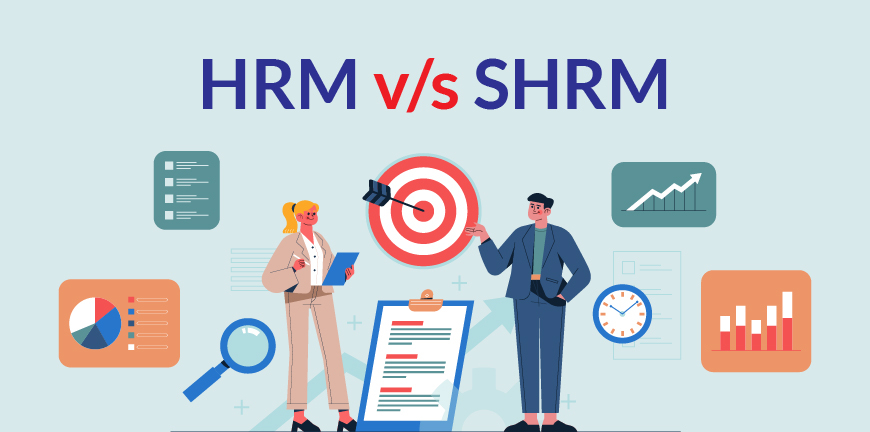
How to Stop Procrastination at Work? 10 Effective Ways
16/06/2023
HRM vs SHRM – Definition, Objectives, Key Differences
22/06/2023- What is Extended Reality?
- How does Extended Reality work?
- What Are the Types of Extended Reality?
- 2. AR (Augmented Reality)
- Use Cases
- What is the Impact of XR (Extended Reality) on Businesses?
- What Are the Benefits of Extended Reality for Businesses?
- What are the Challenges of Extended Reality (XR)?
- What Is the Future of XR?
- Key Takeaways
- Frequently Asked Questions
Imagine walking through a work landscape where the physical and digital world blends perfectly. Engineers witnessed floating machinery repairs along with real machines lying in front of them. Yes, this is the magical world of immersive technologies or Extended Reality (XR) that is set to revolutionise the very core of workplaces.
According to reports, the global XR market was valued at around USD 24.17 billion in 2024 and is projected to climb to about USD 139.07 billion by 2031, representing a compound annual growth rate (CAGR) of ~28.4 %.
It is not some science fiction show; it’s the reality that is penetrating organisations across sectors.
The launch of Apple’s Vision Pro in 2024, a $3500 mixed-reality headset, spiked people’s interest in the term “extended reality. Here’s why! The Apple Vision Pro allows users to see the real world through the headset and also facilitates interaction with digital objects projected onto the real world.
There is no denying that the digital world is running the show today. Of the many technological advancements, XR (Extended Reality) has stood out for the significant impact it has had on businesses.
Extended reality (XR) changed the way of entertain, interact with people, and get our jobs done remotely and securely. The very first case of the impact of extended reality became known when NVIDIA adapted XR, delivering groundbreaking solutions for augmented reality and virtual reality, including leading GPUs, drivers, and SDKs—for professionals, gamers, and developers.
NVIDIA Omniverse XR application delivers the world’s first full-fidelity, fully ray-traced XR experiences. End users’ designers, creators, and engineers will be able to produce 3D virtual worlds at the human scale using the Omniverse XR application.
What is Extended Reality?
Extended Reality is a coined term used to describe the intelligent fusion of physical and virtual places, consisting of Augmented Reality (AR), mixed reality (MR), and virtual reality (VR). It can mean all of them or a combination of two or three. It is essentially a real-world interaction with computer-generated images as well as virtual environments.
India, like other global nations, is also adopting the emerging technology at a rapid pace.
The Indian XR market was valued at US$4.3 billion in 2024 (India Extended Reality market) with a projected reach of US$63.6 billion by 2033, at a CAGR of about 31.07% (2025-33).
The growth is essentially propelled by the high demand for smartphone penetration, affordable data, and use cases expanding across sectors. With government initiatives promoting digital transformations and large companies and startups investing in XR-based training programs and customer experiences, India is on the verge of becoming a top global player.
How does Extended Reality work?
The various components and processes of XR entail:
- Tracking and Stimulations: Several sensors collect data on where a user is positioned, considering the movement, surroundings. Advanced technologies create a map of the physical space.
- Processing Elements- High-impact computers, systems, and processors are used to manage complex calculations to render real-time graphics and handle the vast data from sensors.
- Displays- These visual presentations are the digital content available to users. These can be of various kinds, from screens inside VR headsets to transparent AR glass displays, etc.
- Input Devices- These devices allow users to communicate with virtual or mixed landscapes via voice commands, actions like hand gestures.
What Are the Types of Extended Reality?
Before we dive into the complexities and advantages of XR, let’s give you a brief of what MR, AR, AND VR do and where they find applications.
1. MR (Mixed Reality)
The combination of innovative computer technology, graphics, and input devices that mixes the physical and digital worlds. Some of the industries where MR finds its applications are the entertainment sector, sales and marketing, home and real estate tours, education, training, and simulation. Microsoft’s HoloLens 2 is one of the best examples of MR, as it allows you to place digital objects into the
2. AR (Augmented Reality)
This type of XR is the addition of interactive digital aspects to a live, real-world setting when accessed through a phone, tablet, or headset. The popularity of AR rose due to its advancement, merging audio and digitised imagery using words, animations, and photos.
3. VR (Virtual reality)
VR is a simulated 3D environment that enables users to explore and interact with a virtual environment in a way that feels almost real, as that is how the users perceive it. In the entertainment and gaming industry, Pokémon Go is one of the most popular examples of the successful implementation of Virtual Reality.
Use Cases
XR finds its application in the virtual environment, especially for simulations, as it offers a secure setting. The healthcare industry and medical professionals have a lot to gain from the characteristics of XR.
- Amrita Hospital in Kochi has developed a first-of-its-kind Extended Reality (XR) supported ecosystem in healthcare, leveraging augmented reality (AR), virtual reality (VR), and mixed reality (MR) technologies to significantly enhance capabilities in patient care, medical training, and research.
- Indian eyewear brand Lenskart has integrated AR for “virtual try-on” of glasses, allowing users to see how frames fit via smartphone camera/live AR.
- Indian automotive giants are reported to use VR/AR technologies (e.g., virtual test drives, immersive product experiences) to engage customers.
What is the Impact of XR (Extended Reality) on Businesses?
XR technologies help translate abstract concepts into tangible experiences, offering companies an opportunity to deliver on their promise in unique ways, enhancing productivity, improving efficiency, and engaging customers.
When it comes to extended reality in business, most industries will likely be experiencing maximum disruption due to the extensive efficiency in processes fuelled by XR.
1. Entertainment
XR for entertainment may sound trivial. But here’s some news for you! The XR gaming market is expected to reach $18 billion by this year. Not so trivial, right? Gamers can get a sense of what their chosen scenes would look like in real life, whether they are crossing into another era, or place, or exploring fantastic, futuristic worlds. Customers can virtually experience live music and sporting events while wearing VR headsets.
Media giant Sony has developed a virtual‑production studio solution combining their Crystal LED display tech and Venice camera capture tech to create immersive XR backdrops for film/TV production.
2. Healthcare
During the pandemic, doctors resorted to using XR extensively to offer remote care to patients. Ever since, medical institutions have been experimenting with XR tools for advanced healthcare research, for developing user-based experiments.
Fresenius Medical Care (Germany / global) have implemented the “Stay Safe” training environment: a standalone VR system (no installation) to help both medical professionals and patients learn about chronic‑illness management (specifically kidney disease) in multiple languages
3. Manufacturing
Although the sector has progressed with digital transformations, most manufacturing companies have yet to adapt XR in their industrial processes. The question is, how can the manufacturing sector utilize extended reality? With XR, manufacturers will be able to streamline processes, improve product development, and collaborate effectively. Some of the common use cases in this sector are-
- Rapid product development.
- Robust and improvised training and guidance.
- XR fuelled process improvements and efficiency.
- Quicker maintenance and repair.
- Better collaboration.
4. Product development
Some of the manufacturing firms have been using extended reality to design and manufacture products. The advancement of XR has facilitated the development of products in industries more easily and simply.
With XR development, engineers can easily test the products in virtual and augmented reality and make changes until they have the desired output. In the manufacturing process, it can be used to ensure that workers are overseeing the product assembly and the product line.
5. Engineering and production
A skilled workforce is necessary in the engineering and production industry to enhance productivity. But training workers could end up being a costly affair. With XR, you can save money and time and avoid injuries as designers and clients can immerse themselves while drafting the plans using CAD, enabling greater exploration of design space.
6. Food
From streaming training content to creating a virtual simulation of food production processes or stimulation of real-life scenarios, XR offers a new way of looking at things and executing them. One of the main aspects when it comes to food production is overseeing the hygiene facilities. With MR devices like HoloLens, a digital layer, like routine hygiene inspection, that highlights critical areas that may be overlooked by manual processes, can be added to it.
7. Education
A study by the National Education Association revealed that lectures have a learning retention rate of 5% and reading has a learning retention rate of 10%. Get this, VR apparently has a learning retention rate of 75% as it made learning more engaging with immersive technology.
University of Bristol worked on an AR education project: using web‑based 3D + AR to help engineering students visualise complex machines they might not see up close
8. Marketing and Retail
Virtual reality has paved new paths for brands to engage with consumers, offering immersive ways to interact with new products. Consumers can now experience and visualise goods before making a physical purchase. And for stakeholders, the technologies help them to make a clear-cut purchase decision.
9. Real Estate
Architects and interior designers can leverage XR to bring life to their designs and highlight them to clients, giving them a virtual, real feel of the design. Did you know, with XR, real estate managers and agents can also benefit by streamlining the rental process by allowing potential tenants to view properties virtually, enhancing customer experience while providing strong business opportunities.
What Are the Benefits of Extended Reality for Businesses?
Let us check out some of the significant advantages of ER for businesses:
1. Enhanced Productivity and Efficiency
The presentation of real-time data and instructions into physical work systems by XR makes functions efficient. AR-powered maintenance systems alleviate time spent troubleshooting. XR also helps onsite workers by guiding them through remote experts.
2. Cost Effectiveness
XR can help in cutting down costs in various facets, like prototyping costs in design and manufacturing. Reduces travel and training expenses by conducting online classroom sessions and remote collaborations.
3. Accelerated Partnerships and Remote Work
XR facilitates immersive remote tie-ups across locations. This happens through virtual meetings using 3D platforms, enhancing understanding and coherence. Teams can interact with digital assets in real time from anywhere. XR enables global teams to coordinate and collaborate seamlessly, supporting workforces across the globe, along with GCC and APAC.
4. Improved Client Engagement and Marketing
XR transforms customer experience into something new, making products and services more interesting and engaging.AR applications are advanced, and they enable customers to try a product or experience first before purchasing it. This gives them confidence and builds trust. Professionals in retail and real estate organisations showcase their products remotely by using XR.
5. Innovation and Competitive Edge
Organisations adopting XR in the early stages can drive leadership and innovation to the maximum. The adoption of immersive technologies enables companies to stay ahead of the curve by attracting top talent who are willing to work with advanced technologies. The technologies support digital transformation initiatives and Industry 4.0 efforts.
What are the Challenges of Extended Reality (XR)?
With great power comes great responsibility. Undoubtedly, with the numerous advantages it poses, XR definitely has its own risks as well, which need to be handled responsibly and with care. Some of the main problems companies, business leaders face are-
1. Legal Concerns and Ethical Challenges
The rapid advancement of XR may pave the way for illegal virtual videos and violence to be readily available, causing unrest and potential traumatic events. The absence of clear laws and regulations would magnify these consequences, creating legal issues.
Talking about ethical challenges, XR allows a person to interact virtually with characters online, so the question arises: Should there be a rule of reciprocity to fictional characters in the virtual world? If so, should we overlook the immoral acts? Is superrealism acceptable even when sensitive content is involved?
2. Cybersecurity and privacy
Reflexes, information about preferences, habits, and interests, behavioural patterns, everything is recorded by XR without consent. This could pose hacking issues, such as fake news, body swapping, etc.
3. Health Concerns
XR can sometimes result in overstimulation of the brain, causing dizziness, nausea, and other health issues connected to the brain. Post XR hangovers can be avoided if businesses choose and implement technologies that suit their needs.
What Is the Future of XR?
XR is becoming a reality by the day. It is not a futuristic application or gadget that will fizzle out; it is a game-changing tool that is practical and can fuel efficiency. Innovation and collaboration. Let us look at some of the emerging trends of XR:
Adoption Across Industries- Soon, we will be able to witness XR becoming more mainstream and becoming as common as a smartphone. As per Gartner’s prediction, by 2030, 70% of large enterprises will have integrated some form of XR into daily operations.
Integration of AI- Immersive technologies and XR are already making waves. Imagine if AI is integrated into these technologies. There will be a power-packed explosion where AI will be redefining XR. We will shift from pre-programmed XR experiences to adjustable, interactive, and personalised landscapes.
Maturing of the Metaverse- We will witness the advent of micro metaverses, domain-centric immersive ecosystems, solving real-world issues rather than notional entertainment. We will have smart cities utilising XR for urban development, education systems integrating immersive learning, and many more.
Better Ethical Standards and Affordability- Data ethics and sustainability are set to become an intrinsic part of XR systems, and they will focus on energy efficiency, privacy concerns, and accessibility. XR will be affordable with 5G and 6G networks available anywhere, enabling real-time experiences.
We are stepping into a brand-new gamut of technologically advanced experiences of holistic XR applications, where these applications are likely to break barriers and enhance our capabilities in making empowered decisions in various facets of any industry. Processing, retaining, and absorbing information will be smooth. The challenges along the way will be overcome as we progress towards the reality transforming our personal and professional existence.
Key Takeaways
- XR is Revolutionising Workplaces and Industries
- Rapid Market Growth Globally and in India
- Significant Business Benefits
- Challenges: Ethics, Privacy, and Health
- The Future: AI Integration and Mainstream Adoption
Frequently Asked Questions
1. What is Extended Reality (XR)?
Extended Reality, or XR, is an immersive technology that includes Virtual Reality(VR, Augmented Reality(AR), and Mixed Reality (MR).
2. What is the difference between AR, VR, and XR?
VR or Virtual Reality is a complete immersion into the virtual world, while Augmented Reality or AR puts out digital information into the real world, and Mixed Reality or MR is a mix of virtual components and the real world.
3. How is Extended Reality used in business?
XR is used in businesses for accelerating customer experiences, employee training, enhancing product design and services, etc.
4. What are the benefits of XR?
Extended Reality is advantageous in many ways, like it drives innovation, enhances learning and development through immersive technologies, enhances client experience, etc.
5. What is the future of XR?
The future of XR entails smarter and accessible devices, expanded integration, AI having an integral role to play, wider application adoption, etc.
Contact Us For Business Enquiry

Rajkumar Shanmugam
Rajkumar Shanmugam is the Head of HR at ALP Consulting, bringing over 19 years of comprehensive HR leadership experience across India and international markets. His expertise spans talent acquisition, employee relations, performance management, compliance, and HR transformation. Rajkumar has a proven track record of driving people-centric initiatives, enhancing workplace culture, and aligning HR strategy with business goals. With extensive experience in US staffing operations and global mobility, he continues to lead organizational excellence through innovation and employee engagement.




